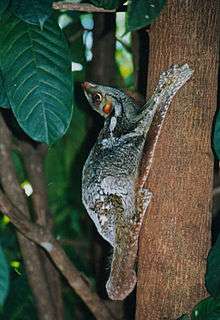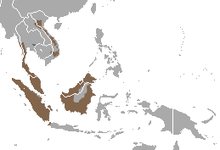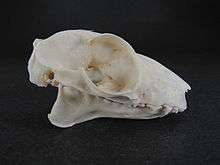Sunda flying lemur
The Sunda flying lemur (Galeopterus variegatus) or Sunda colugo, also known as the Malayan flying lemur or Malayan colugo, is a species of colugo. Until recently, it was thought to be one of only two species of flying lemurs, the other being the Philippine flying lemur, which is found only in the Philippines. This species can be found throughout Southeast Asia ranging from Indonesia, Thailand, Malaysia, southern Vietnam, southern Burma, and Singapore.[3]
| Sunda flying lemur[1] | |
|---|---|
 | |
| Galeopterus variegatus | |
| Scientific classification | |
| Kingdom: | Animalia |
| Phylum: | Chordata |
| Class: | Mammalia |
| Order: | Dermoptera |
| Family: | Cynocephalidae |
| Genus: | Galeopterus Thomas, 1908 |
| Species: | G. variegatus |
| Binomial name | |
| Galeopterus variegatus (Audebert, 1799) | |
 | |
| Sunda flying lemur range | |
The Sunda flying lemur is not a lemur and does not fly. Instead, it glides as it leaps among trees. It is strictly arboreal, is active at night, and feeds on soft plant parts such as young leaves, shoots, flowers, and fruits. After a 60-day gestation period, a single offspring is carried on the mother's abdomen held by a large skin membrane.[4] It is a forest-dependent species.
The head-body length of Sunda flying lemur is about 33 to 42 cm (13 to 17 in). Its tail length measures 18 to 27 cm (7.1 to 10.6 in),[5] and its weight is 0.9 to 1.3 kg (2.0 to 2.9 lb).
The Sunda flying lemur is protected by national legislation. The Sunda flying lemurs are often hunted by locals with spears or other lethal equipment for various reasons such as food and fur. Habitat loss is known to occur intermittently, particularly in developing countries such as Malaysia.[3] In addition to deforestation and loss of habitat, local subsistence hunting poses a serious threat to this animal. Competition with the plantain squirrel (Callosciurus notatus) represents another challenge for this species. More information is needed on population declines, but at present, the rate of the decline is not believed to merit listing in any category lower than least concern.[2]
Classification and evolution


The Sunda flying lemurs' two forms are not morphologically distinct from one another; the large form occurs on the mainland of the Sunda Shelf area and the mainland of Southeast Asia, while the dwarf form occurs in central Laos and some other adjacent islands.[1] The Laos specimen is smaller (about 20%) than the other known mainland population.[6] Despite the large and dwarf forms, four subspecies are known: G. v. variegatus (Java), G. v. temminckii (Sumatra), G. v. borneanus (Borneo), and G. v. peninsulae (Peninsular Malaysia and mainland of Southeast Asia)[1] incorporating on the genetic species concept due to geographic isolation and genetic divergence. Recent molecular and morphological data provide the evidence that the mainland, Javan, and Bornean Sunda flying lemur subspecies may be recognised as three separate species in the genus Galeopterus.[7]
Habits and lifestyle
Sunda flying lemurs live either solitary or in small groups that are loosely connected. They can be territorial in foraging and sleeping areas. They are mainly nocturnal. They are strictly arboreal and in the daytime, they sleep high within dense foliage in the treetops or in holes in trees. With all four of their feet, they cling on to the trunk of a tree or the underside of branches. Climbing involves stretching out their two front legs and then bringing up their two back legs, which results in an awkward hopping. They can glide more than 100 m with minimal loss in elevation. When threatened, they either climb higher up or remain motionless. These animals are quite helpless if on the forest floor.
Behaviour and ecology
The Sunda flying lemur is a skillful climber, but is helpless when on the ground.[8] Its gliding membrane connects from the neck, extending along the limbs to the tips of the fingers, toes, and nails.[9] This kite-shaped skin is known as a patagium, which is expanded for gliding. It can glide over a distance of 100 m with a loss of fewer than 10 m in elevation.[9] It can maneuver and navigate while gliding, but strong rain and wind can affect its ability to glide. Gliding usually occurs in open areas or high in the canopy, especially in dense tropical rainforest. The Sunda flying lemur needs a certain distance to glide and to land to avoid injury.[10] The highest landing forces are experienced after short glides; longer glides lead to softer landings, due to the colugo's ability to break its glide aerodynamically. The ability to glide increases a colugo's access to scattered food resources in the rainforest, without increasing exposure to terrestrial or arboreal predators.[11]
In general, the diet of the Sunda flying lemur consists mainly of leaves. It usually consumes leaves with less potassium and nitrogen-containing compounds, but with higher tannin.[12] It also feeds on buds,[13] shoots,[14] coconut flowers, durian flowers,[15] fruits, and sap[16] from selected tree species. It also feeds on insects in Sarawak, Malaysian Borneo.[17] The selected food sources depend on the localities, habitat, vegetation types, and availability.[18]
The Sunda flying lemur mainly forages in tree canopies. It may forage on several different tree species in a single night,[19][20] or on a single species. It can also be seen licking tree bark of selected tree species to obtain water, nutrients, salts, and minerals.[21] Though the Sunda flying lemur has been reported to also occur in gardens and plantations, the species resides in forests primarily.[22]
Distributions and habitats
The Sunda flying lemur is widely distributed throughout Southeast Asia, ranging from the Sunda Shelf mainland to other islands – Northern Laos,[6] Cambodia, Vietnam, Thailand, Malaysia (Peninsular, Sabah and Sarawak), Singapore, Brunei, Indonesia (Kalimantan, Sumatra, Bali, Java),[1][23] and many adjacent islands.[14] Conversely, the Philippine flying lemur (C. volans) is confined to the southern parts of the Philippines only.[1]
The Sunda flying lemur is adapted to many different vegetation types, including gardens, primary and secondary forest,[24] rubber and coconut plantations,[25] fruit orchards (dusun),[15] mangrove swamps,[13] lowlands and upland forests,[9][26] tree plantations,[14] lowland dipterocarp forests, and mountainous areas,[16] but not all of these habitats can sustain large colugo populations.[22]
| Wikimedia Commons has media related to Galeopterus variegatus. |
| Wikispecies has information related to Galeopterus variegatus |
References
- Stafford B.J.; Szalay F.S. (2000). "Craniodental functional morphology and taxonomy of Dermopterans". Journal of Mammalogy. 81 (2): 360–385. doi:10.1093/jmammal/81.2.360.
- Boeadi; Steinmetz, R. (2008). "Galeopterus variegatus". IUCN Red List of Threatened Species. 2008: e.T41502A10479343. doi:10.2305/IUCN.UK.2008.RLTS.T41502A10479343.en.
- Nasir, M. D., & Abdullah, M. T. (2010). Distribution of the Sunda Colugo (Galeopterus variegatus) in Malaysia (Peninsular, Sabah, Sarawak). Tropical life sciences research, 21(2), 69–83.
- Burnie, David; Wilson, Don E., eds. (2005-09-19). Animal: The Definitive Visual Guide to the World's Wildlife (1st paperback ed.). Dorling Kindersley. ISBN 0-7566-1634-4.
- Shepherd, Chris R.; Shepherd, Loretta Ann (2012). A Naturalist's Guide to the Mammals of Southeast Asia. Wiltshire, UK: John Beaufoy Publishing. p. 17. ISBN 978-1-906780-71-5.
- Ruggeri N.; Etterson M. (1998). "The first record of colugo (Cynocephalus variegatus) from the Lao P.D.R.". Mammalia. 62 (3): 450–451. doi:10.1515/mamm.1998.62.3.439.
- Janecka J.E.; Helgen K.M.; Lim N.T.L.; Baba M.; Izawa M.; Boeadi; Murphy W.J. (2008). "Evidence for multiple species of Sunda Colugo". Current Biology. 18 (21): R1001–2. doi:10.1016/j.cub.2008.09.005. PMID 19000793.
- Vaughan, T.A. (1986). Mammalogy. 3rd edition. Saunders College Publishing, Philadelphia.
- Feldhamer, G.A., Drickamer, L.C., Vessey, S.H. and Merritt, J.F. (2003). Mammalogy: adaptation, diversity, and ecology. 2nd edition. McGraw-Hill Companies Inc., New York.
- Byrnes G.; Norman T.-L. Lim; Andrew J. Spence (2008). "Take-off and landing kinetics of a free-ranging gliding mammal, the Malayan Colugo (Galeopterus variegatus)". Proceedings of the Royal Society B: Biological Sciences. 275 (1638): 1007–1013. doi:10.1098/rspb.2007.1684. PMC 2600906. PMID 18252673.
- Byrnes G.; Libby Thomas; Norman T.-L. Lim; Andrew J. Spence (2011). "Gliding saves time but not energy in Malayan Colugos". Journal of Experimental Biology. 214 (16): 2690–2696. doi:10.1242/jeb.052993. PMID 21795564.
- Agoramoorthy G.; Sha C.M.; Hsu M.J. (2006). "Population, diet and conservation of Malayan flying lemurs in altered and fragmented habitats in Singapore". Biodiversity and Conservation. 15 (7): 2177–2185. doi:10.1007/s10531-004-6900-1.
- Yasuma, S. and Andau, M. (2000). Mammals of Sabah Part-2, habitat and ecology. Tian Sing Printing Co. Sdn.Bhd, Kota Kinabalu.
- Francis, C.M. (2008). A field guide to the mammals of south-east Asia. New Holland Publishers (UK) Ltd., London.
- Ketol B.; Abdullah M.T.; Tedong S. (2006). "Short notes: Distribution records of the rare flying lemur in Kota Samarahan and Kuching Area, Sarawak". Sarawak Museum Journal. 83: 237–241.
- Lim, B.L. (1967). Observations on the food habits and ecological habitat of the Malaysian flying lemur. International Zoo Yearbook. Scotland, Aberdeen University Press. 7: 196-197.
- Davis D D. (1958). Mammals of the Kelabit Plateau Northern Sarawak. Chicago: Chicago Natural History Museum.
- Sih, A. (1993). Effects of ecological interactions on forager diets: Competition, predation risk, parasitism and prey behavior. In diet selection: An interdisciplinary approach to foraging behavior (Hughes, R.N. eds). Blackwell scientific publications. Cambridge University Press, England.
- Wischusen, E.W. (1990). The foraging ecology and natural history of the Philippine flying lemur (Cynocephalus volans). PhD Thesis. Cornell University, Ithaca, New York.
- Wischusen E.W.; Richmond M.E. (1998). "Foraging ecology of the Philippine Flying Lemur (Cynocephalus volans)". Journal of Mammalogy. 79 (4): 1288–1295. doi:10.2307/1383020. JSTOR 1383020.
- Lim, N.T-L. (2007). Colugo: The flying lemur of South-East Asia. Draco Publishing and Distribution Pte Ltd., Singapore.
- Lim N.T.-L.; Giam X.; Byrnes G.; Clements G.R. (2013). "Occurrence of the Sunda colugo (Galeopterus variegatus) in the tropical forests of Singapore: A Bayesian approach". Mammalian Biology. 78: 63–67. doi:10.1016/j.mambio.2012.06.008.
- Corbet, G.B. and Hill, J.E. (1992). The mammals of the Indomalayan region: A systematic review. Natural History Museum Publications. Oxford University Press, Oxford
- Lekagul, B. and McNeely, J.A. (1977). Mammals of Thailand. Kurusapha Ladprao Press, Bangrak (Bangkok).
- Hill, J.E. (1993). Flying lemurs (in encyclopedia of animals). Weldon Owen Pty Limited, Singapore.
- Payne, J., Francis, C.M. and Phillipps, K. (1985). A field guide to the mammals of Borneo. Sabah Society, Kota Kinabalu.
External links
- View the galVar1 genome assembly in the UCSC Genome Browser.
Further reading
- Anon, (2008). Flying lemurs mating, Bako National Park, Sarawak, Malaysia. https://www.youtube.com/watch?v=wavNc4nuVyk. Accessed date October 7, 2008.
- Byrnes G.; Libby Thomas; Norman T.-L. Lim; Andrew J. Spence (2011). "Gliding saves time but not energy in Malayan Colugos". Journal of Experimental Biology. 214 (16): 2690–2696. doi:10.1242/jeb.052993. PMID 21795564.
- Chapman H.C. (1902). "Observations upon Galeopithecus volans". Proceedings of the Academy of the Academy of Natural Science of Philadelphia. 54: 241–254.
- Chasen F.N.; Kloss C.B. (1929). "Notes on flying lemurs (Galeopterus)". Bulletin of the Raffles Museum. 2: 12–22.
- Dzulhelmi M.N.; Abdullah M.T. (2009a). "An ethogram construction for the Malayan flying lemur (Galeopterus variegatus) in Bako National Park, Sarawak, Malaysia". Journal of Tropical Biology and Conservation. 5 (1): 31–42.
- Dzulhelmi M.N.; Abdullah M.T. (2009d). "The foraging ecology of the Sunda Colugo (Galeopterus variegatus) in Bako National Park, Sarawak, Malaysia". Malayan Nature Journal. 61 (4): 285–294.
- Dzulhelmi M.N.; Abdullah M.T. (2010). "Distribution of the Sunda Colugo (Galeopterus variegatus) in Malaysia (Peninsular, Sabah and Sarawak)". Journal of Tropical Life Sciences Research. 21 (2): 69–83.
- Dzulhelmi, M.N., Marzuki, H. and Abdullah, M.T. (2010). Observation on the roosting selection of the Sunda Colugo (Galeopterus variegatus) in Bako National Park, Sarawak, Malaysia. Proceedings of Conference on Natural Resources in the Tropics3: Harnessing Tropical Natural Resources Through Innovations and Technologies. pp. 433–439.
- Dzulhelmi, M.N. (2011). Behavioural Ecology of the Sunda Colugo Galeopterus variegatus (Mammalia: Dermoptera) in Bako National Park, Sarawak, Malaysia . MSc. Dissertations. Universiti Malaysia Sarawak, Kota Samarahan.
- Dzulhelmi, N. (2013). Natural History of the Colugo. UKM Press: Bangi.
- Ellerman, J.R. and Morrison-Scott, T.C.S. (1955). Supplement to Chasen, F.N. (1940): A handlist of Malaysian mammals. British Museum. Tonbridge Printers Ltd., London.
- Janecka J.E.; Miller W.; Pringle T.H.; Wiens F.; Zitzmann A.; Helgen K.M.; Springer M.S.; Murphy W.J. (2007). "Molecular and genomic data identify the closest living relative of primates". Science. 318 (5851): 792–794. doi:10.1126/science.1147555. PMID 17975064.
- Karim C.; Tuen A.A.; Abdullah M.T. (2004). "Mammals. Sarawak Bau Limestone Biodiversity". Sarawak Museum Journal. 6 (80): 221–234.
- Khan, M.M. (1992). Mamalia semenanjung Malaysia. Department of Wildlife and National Parks, Kuala Lumpur.
- Kool, K.M. and Nawi, Y. (1995). Catalogue of skin in Sarawak museum, Kuching, Sarawak. Universiti Malaysia Sarawak, Kota Samarahan.
- Lewis R.E. (1986). "A rain-forest raptor in danger". Oryx. 20 (3): 170–175. doi:10.1017/s0030605300020032.
- Lim, N.T. (2004). Autecology and a preliminary population census of the Malayan flying lemur Cynocephalus variegatus in Singapore. BSc. Final Year Project. National University of Singapor, Singapore.
- Martin R.D. (2008). "Colugos: obscure mammals glide into the evolutionary limelight". Journal of Biology. 7 (4): 13. doi:10.1186/jbiol74. PMC 2397492. PMID 18466644.
- Maryanto, I., Anang, S.A., and Agus, P.K. (2008). Mamalia dilindungi perundang-undangan Indonesia. LIPI Press, Jakarta.
- Medway, L. (1978). The wild mammals of Malaya (Peninsular Malaysia) and Singapore. Oxford University Press, Kuala Lumpur.
- Mohd-Azlan J.; Fauzi M.F. (2006). "Ethnozoological survey in selected areas in Sarawak". Sarawak Museum Journal. 83: 185–200.
- Miller G.S. Jr (1906). "The nomenclature of flying lemur". Proceedings of the Biological Society of Washington. 19: 41–48.
- Nie W.; Fu B.; O'Brian P.C.M.; Wang J.; Su W.; Tanomtong A.; Volobouev V.; Ferguson-Smith M.A.; Yang F. (2008). "Flying lemurs – the "flying tree-shrews"? molecular cytogenetic evidence for a Scandentia-Dermoptera sister clade". BMC Biology. 6: 18. doi:10.1186/1741-7007-6-18. PMC 2386441. PMID 18452598.
- Novacek M.J. (1992). "Fossils, topologies, missing data, and higher level phylogeny of eutherian mammals". Systematic Biology. 41 (1): 58–73. doi:10.1093/sysbio/41.1.58.
- Novacek M.J. (1993). "Mammalian phylogeny: morphology and molecules". Trends in Ecology & Evolution. 8 (9): 339–340. doi:10.1016/0169-5347(93)90245-k.
- Nowak, R.M. (1999). Mammals of the world. 6th edition. Johns Hopkins University Press, Baltimore.
- Parr, J.W.K., Komolphalin, K. and Wongkalasin, M. (2003). A guide to the large mammals of Thailand. Sarakadee Press, Bangkok.
- Penry, D.L. (1993). Digestive constraints on diet selection. In diet selection: An interdisciplinary approach to foraging behaviour (Hughes, R.N. eds). Blackwell Scientific Publications. Cambridge University Press, Cambridge.
- Pettigrew J.D. (1995). "Flying primates: crashed or crashed through?". Symp. Zoological Society of London. 67: 3–26.
- Schmitz J.; Ohme M.; Suryobroto B.; Zichler H. (2002). "The colugo (Cynocephalus variegatus), Dermoptera: the Primates' gliding sister?". Molecular Phylogenetics and Evolution. 19 (12): 2308–2312. doi:10.1093/oxfordjournals.molbev.a004054. PMID 12446821.
- Schmitz J.; Ohme M.; Zichler H. (2003). "A novel family of tRNA-derived SINEs in the colugo and two new retrotransposable markers separating dermopterans from primates". Molecular Phylogenetics and Evolution. 28 (2): 341–349. doi:10.1016/s1055-7903(03)00060-5. PMID 12878470.
- Stephen, D.W. and Krebs, J.R. (1986). Foraging theory. Princeton University Press, England.
- Wharton C.H. (1950). "Notes on the life history of the flying lemur". Journal of Mammalogy. 31 (3): 269–273. doi:10.2307/1375292. JSTOR 1375292.
- Wischusen E.W.; Richmond M.E. (1989). "Techniques for capturing and marking the Philippine flying lemurs (Cynocephalus volans)". Malayan Nature Journal. 43: 100–105.

%2C_Central_Catchment_Area%2C_Singapore_-_20060618.jpg)